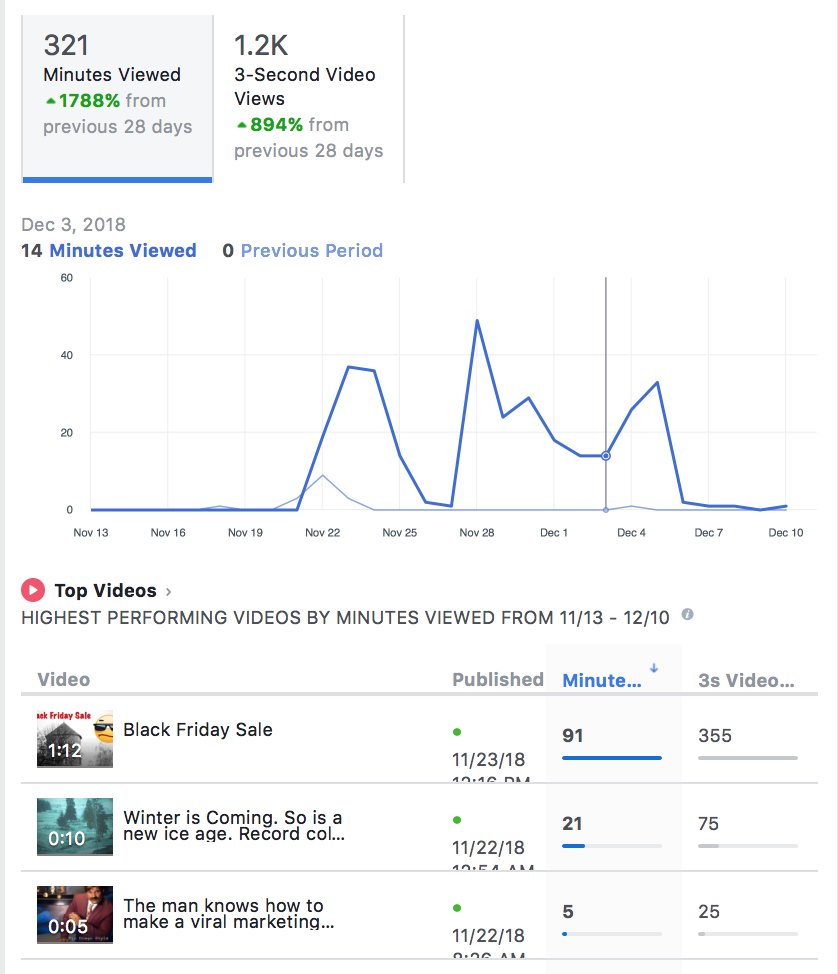For marketers and businesses, this time of year is one of the most chaotic seasons we’ve got. Not only are we dealing with the end of year insanity with holiday deals, we also have to be doing a year-end review and diligently creating the strategies that will carry us into 2019.
Video marketing has continued to grow in importance throughout 2018, and that won’t be changing any time soon. Because of this, alongside the emergency of new trends and use cases, it’s important to take some time before diving into 2019 to assess what video marketing strategies are working for you and how they should be adjusted or changed for the new year.
In this post, we’re going to show you how to assess and create your video marketing plan for 2019 so that you’ll be ready to hit the ground running and make it your best year yet.
1. Assess Your Current Content Performance
Before you do anything else, look at where you stand now. Create a quick report that dives deep into the results you get on each platform, and the strategies that you’re using. Look at factors like video length and style, the platforms you’re using, and the types of storytelling that you’re implementing in your content.
Once you do this, match up the different types of content with their performance metrics. Look for engagement like clicks, shares, and reactions, alongside number of views and view completion/retention rates. High views means that your reach on certain platforms are good, but a high view count with low completion or click-through rates indicate that the content is relevant or powerful enough to drive actions.

You can use native analytics tools to help with this. Facebook, Instagram, Twitter, and YouTube each of their own analytics information that can give you specific performance metrics on each video, along with overall trends.
At this stage, make a clear note of what working and what isn’t. Your 2019 strategy needs to be adapted based on this information, potentially improving what’s working in addition to some strategies that might be falling a little flat if you don’t decide to get rid of them all together.
How to Decide What Needs to Be Changed
There’s no real iron-clad way to know when a certain strategy can be improved more. This is true whether you’re seeing great results on a specific technique, or really terrible results.
Here’s my general rule of thumb:
- Even great strategies that are performing well potentially have room for improvement if we can find why they’re doing well and focus on that.
- Content that’s getting ok initial view rates but poor completion rates or engagement need some work. Maybe the types of videos aren’t resonating, or they’re too long, or the story doesn’t move the audience the way you’d hope.
- Videos getting almost no views and pretty much zero engagement are not at all relevant to your target audience. Go ahead and scrap these strategies because they aren’t working for you.
Testing will ultimately be the only way to know for sure and find new tweaks on strategies that will improve what you’re already doing.
2. Evaluate Your Video Marketing Budget
If you’re already investing in video marketing, you’ve definitely had a marketing budget. This budget will include what you pay for video creation, consulting, script writing, editing, and distribution, along with the tools to help you do so.
A lot of articles that you’ll read about video in marketing for 2019 tell you that the only way is to significantly increase your marketing budget in the new year. While we’d never disagree that a higher marketing budget is a good thing, having the right tools will ensure that the ad spend is going to the right places.
Hiring a videographer team to come in and shoot high quality clips, for example, is a good investment, as is investing into a distribution strategy that will help you maximize reach.
There are, however, tools available that will help you stretch your budget further; Shakr offers video creation templates that allow you to compile images and video clips into our templates, customize the text, and puts it all together for you with some theme music. Skip out on the video editor and save money with our software so that you can invest that marketing spend elsewhere.
3. Look for Opportunities to Diversify Content
Right now, you’ve got several strategies that you’re using. This may include using Stories for brand awareness, sharing product tutorials to YouTube, and using live video to engage viewers.
Maybe you’re missing the opportunity to share DIY content to Instagram, brand stories to Facebook or LinkedIn, or insider tips in general. Evaluate the strategies that you’re currently using, and see if there are other types of content you can create that will appeal to your audience.
You can test out different types of videos, including Q&A content, influencer content, and general education content. You can also try diversifying the styles of videos you create; maybe some will have voice-over narration, while others are a direct interview with employees, customers, or team members.
4. Consider Your Goals
It’s important to look at the overall marketing and business goals that you have for 2019 so you can see how video marketing fits into it.
You may, for example, want to grow your social following or generate more leads, and you want to use video to help with that.
Use your goals to shape your strategies.
If you want to grow your social media followings, create story-based ads that focus on your brand mission, upload them natively to each platform, and then boost the posts to collect more social proof while expanding your reach.
If you decide that you want to generate more leads, set up a series of valuable, how-to content on YouTube, and then have a CTA at the end of each video sending users to a relevant lead magnet like an ebook or webinar that answers their questions further.
Carefully examine each of your goals, and try to find specific strategies that will allow you to reach them faster with video.
5. Identify Brand Features & Stories To Tell
At this point in the process, you likely have a solid idea about what types of strategies you want to use. It helps when developing a solid marketing plan to not only have specific strategies in mind, but also specific video storyboards.
This could include having a list of product features or brand stories that you want to make sure you highlight throughout the next year. Having a list of topics will help you create relevant, seamless campaigns and promote them well, and it can also give you direction. If you decide to make a lot of of your videos all at one time, this can help you do so.
Let’s see an example of what this might look like. The tampon company Lola has had several incredible campaigns this year, with videos like the following:
An imaginary list for them might look like this:
- Interview founders about why they started the company.
- Provide general education about the unhealthy chemicals found in conventional products.
- Product-oriented video highlighting safety and chemical-free nature of products.
- Ask founders and influencers their first-period stories for brand storytelling.
6. Take 2019 Video Trends into Consideration
No matter how effective your video strategies have been in 2018, this is one area where you’re guaranteed to need to adjust your strategy. Best practices do change as new features and platforms emerge and viewer behavior shifts. As a result, there are a few trends that you need to take into account when moving into 2019 to stay on top, including:
- Go mobile. All of your video content needs to be mobile optimized. This means prioritizing vertical content and keeping the videos relatively short will be a good choice. You should also ensure that any landing page your videos send users to are mobile-optimized.
- Go live. Live videos are becoming the most highly engaging and frequently watched videos on multiple platforms, including Facebook. Make sure that live video is incorporated into your strategy.
- Get interactive. Do what you can to make your video content more engaging and interactive. Users are expecting more, and keeping the videos dynamic will go a long way. Examples of this include adding polls to your videos, 360 video, using scrollable Canvas Ads, and live content where you encourage user questions.
- Look into augmented or virtual realities. Virtual reality is too expensive for many small businesses, but augmented reality is a great solution. You can hire developers to help you create reality-based video experiences that are truly personalized to your customers. Even something as simple as someone being able to “try on” that lipstick shade or see how your sofa would look in their living room can go a long way. You can read more about this here.
7. Evaluate Your Distribution Methods
What does your current distribution strategy look like? Are you just posting YouTube links to Facebook and Twitter? (Please don’t do this: native content performs better).
Take a look at all the distribution strategies you’re currently using, and look for new opportunities to connect your video content to more audience members. This might include:
- Sharing Stories to both Facebook and Instagram
- Sharing an Instagram Live onto Facebook afterwards, increasing reach and views
- Using Facebook Ad or Instagram Ad campaigns to give your storytelling video ad a boost
- Embedding videos onto your site, blog posts, or landing pages to add value to the site and increasing relevant views on your page.
- Incorporating video SEO, including video sitemaps, .SRT files, and keyword-focused video descriptions and titles.
- Including video in your email campaigns.
- Partnering up with other businesses and creating videos involving both of you to increase shares and visibility.
Conclusion
Video marketing was important in 2018, and it will continue to be even more important in the coming years. Take the time now to assess your strategies and create a new video marketing plan that will carry you into 2019.
Best practices have changed over the past year, with new features becoming available and user behavior changing due to a number of different factors. Take that into consideration, and adapt accordingly so that you’ll find success instead of finding yourself stuck.
What do you think? Have you created your video marketing strategy for 2019? What new strategies and techniques are you going to focus on in the new year? Share your thoughts and questions in the comments below!



1 comments On New Year, New Strategy: Creating Your Video Marketing Plan for 2019
Pingback: New Year, New Strategy: Creating Your Video Marketing Plan for 2019 | Local Business Hero ()
Comments are closed.